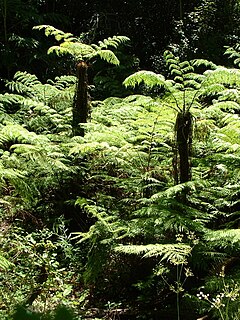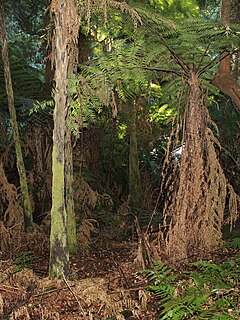
The Cyatheaceae are a family of ferns, the scaly tree ferns, one of eight families in the order Cyatheales in the Pteridophyte Phylogeny Group classification of 2016. Alternatively, the family may defined much more broadly as the only family in the Cyatheales, with the PPG I family treated as the subfamily Cyatheoideae. The narrower circumscription is used in this article.

Alsophila australis, synonym Cyathea australis, also known as the rough tree fern, is a species of tree fern native to southeastern Queensland, New South Wales and southern Victoria in Australia, as well as Tasmania and Norfolk Island.
Alsophila balanocarpa, synonym Cyathea balanocarpa, is a species of tree fern native to Cuba, Jamaica and Hispaniola. Despite its wide distribution, little is known about this species. It is apparently of hybrid origin.
Alsophila brooksii, synonym Cyathea brooksii, is a species of tree fern native to Cuba, Hispaniola and Puerto Rico, where it grows on serpentine soils in shaded ravines, along streams, and on forested slopes at an altitude of 250–950 m. The trunk is prostrate and only about 6 cm in diameter. Fronds are pinnate or bipinnate and up to 2 m long. The base of the rachis is covered with blackish scales that have a paler margin. Sori occur in two rows, one along each side of the pinnule midvein.

Alsophila capensis, synonym Cyathea capensis, is a regionally widespread and highly variable species of tree fern. It is indigenous to Southern Africa and South America.
Alsophila caudata, synonym Cyathea caudata, is a species of tree fern native to the islands of Luzon and Mindanao in the Philippines, where it grows in montane forest. The trunk is erect and up to 4 m tall or more. Fronds are bi- or tripinnate and 1–2 m long. The stipe is warty and covered with dark, narrow, glossy scales. Sori are borne near the midvein of fertile pinnules and are protected by firm, brown indusia. As of April 2022, Plants of the World Online treated it as a synonym of Alsophila speciosa.
Alsophila jimeneziana, synonym Cyathea crassa, is a species of tree fern endemic to the Dominican Republic. Little is known about this rare tree fern.

Alsophila cunninghamii, synonym Cyathea cunninghamii, also known as the gully tree fern and slender tree fern, is a species of tree fern indigenous to New Zealand including North Island, South Island and Chatham Islands; also to Victoria, possibly New South Wales, southeastern Queensland and Tasmania in Australia. It grows in damp forest, often emerging from stream gullies and riverbanks. Brownsey noted that it has a lower tolerance for drought than other related species. The erect trunk may be 20 m tall and is usually 6–15 cm in diameter, occasionally as much as 20 cm. Fronds are tri- to tetrapinnate and 3 m or more in length. The rachis and stipe are slender, black brown, warty and covered with brown scales. Sori occur along each side of the pinnule midvein and are covered by hood-like indusia. A. cunninghamii is an uncommon and slow-growing tree fern.

Alsophila dregei, synonym Cyathea dregei, is a widespread species of tree fern in southern Africa.
Alsophila fulgens, synonym Cyathea fulgens, is a species of tree fern native to Cuba, Jamaica and Hispaniola. It forms part of the complex centered on Alsophila woodwardioides comprising six very similar taxa from the Greater Antilles. The other five species are Alsophila jimeneziana, Alsophila grevilleana, Alsophila portoricensis and Alsophila tussacii. Large and Braggins (2004) note that this group is known to cross with members of the Alsophila minor complex. In the wild, A. fulgens also forms hybrids with Alsophila brooksii.
Alsophila gigantea, synonym Cyathea gigantea, is a species of tree fern native to northeastern to southern India, Sri Lanka, Nepal to Myanmar, Thailand, Laos, Vietnam, the Malay Peninsula, as well as central Sumatra and western Java. It grows in moist open areas at an altitude of 600–1000 m. The trunk of this species is erect and may be as tall as 5 m or more. Fronds are bi- or tripinnate and usually 2–3 m long. The rachis is long, dark to black in colouration and rough in appearance after the fall of scales. These scales are dark brown, glossy and have a narrow paler margin and fragile edges. Sori are round and indusia absent.
Alsophila grevilleana, synonym Cyathea grevilleana, is a species of tree fern endemic to Jamaica, where it grows in moist gullies and on wooded hills in both calcareous and noncalcareous soils at an altitude of 200–1200 m. The trunk of this plant is erect, about 7 m tall, and 10–15 cm in diameter. It is characteristically clothed in old stipe bases, brown scales and blackish spines. Fronds are tripinnate, dark green in colour, and up to 4 m in length. The last pinnae are sometimes separated, forming a distinctive clump around the trunk apex. The rachis is yellow-brown and almost smooth. This species has a long, dark brown stipe with a few scattered spines. Sori are produced in four to six pairs along the pinnule midvein. They are protected by pale brown indusia that are cup-like in appearance.
Alsophila × marcescens, synonym Cyathea × marcescens, commonly known as the skirted tree fern, is a tree fern endemic to the Cape Otway ranges in Victoria and Tasmania, Australia. It is a natural hybrid, apparently Alsophila australis × Alsophila cunninghamii. Large and Braggins (2004) note that it has characteristics midway between these two species. The spores of A. × marcescens are usually malformed although sterile. The trunk of this plant is erect and up to 10 m tall. Fronds may be bi- or tripinnate and 3–4 m in length. Dead fronds often persist, forming a characteristic skirt around the trunk. The stipe is thick, black and warty. The rachis and trunk are covered in shiny, dark brown scales. Sori are borne near the fertile pinnule midvein and are protected by thin indusia that are saucer-like in appearance.
Alsophila imbricata, synonym Cyathea imbricata, is a species of tree fern endemic to Western New Guinea, where it grows in open forest at an altitude of 3240 m. The trunk of this plant is erect and approximately 2 m tall. Fronds may be bi- or tripinnate and are usually less than 1 m in length. The stipe is dark, spiny, and covered with caducous scales. These scales are glossy brown in colouration and have a paler margin and fragile edges. Sori are borne in groups of one to four per pinnule lobe. They are protected by firm indusia.
Alsophila javanica, synonym Cyathea javanica, is a species of tree fern native to western Java and Sumatra, in Indonesia. It grows in rain forest and on riverbanks at an altitude of 250–1500 m.
Alsophila × fagildei is a tree fern endemic to the Sierra de Moa and Sierra del Purial in Guantánamo Province, Cuba. It is a natural interspecific hybrid between Alsophila minor and Alsophila woodwardioides. The spores of A. × fagildei are normal in appearance; Caluff and Serrano (2002) suggest that it might therefore be fertile.

Alsophila is a genus of tree ferns in the family Cyatheaceae. It has also been considered to be a section in the subgenus Cyathea of the genus Cyathea.

Alsophila podophylla, synonym Cyathea podophylla, is a widespread species of tree fern native to southern China, Taiwan, Vietnam, Laos, Thailand, Cambodia, and the Ryukyu Islands. It grows in forest by streams and in ravines at an altitude of 600–1000 m.

Alsophila smithii, synonym Cyathea smithii, commonly known as the soft tree fern or kātote, is a species of tree fern from New Zealand.

Alsophila leichhardtiana, synonym Cyathea leichhardtiana, the prickly tree fern, is a plant in the tree fern family, Cyatheaceae, found in eastern Australia. It is a common species found in moist situations, in and near rainforests. It was named in honour of the explorer and botanical collector Ludwig Leichhardt.







